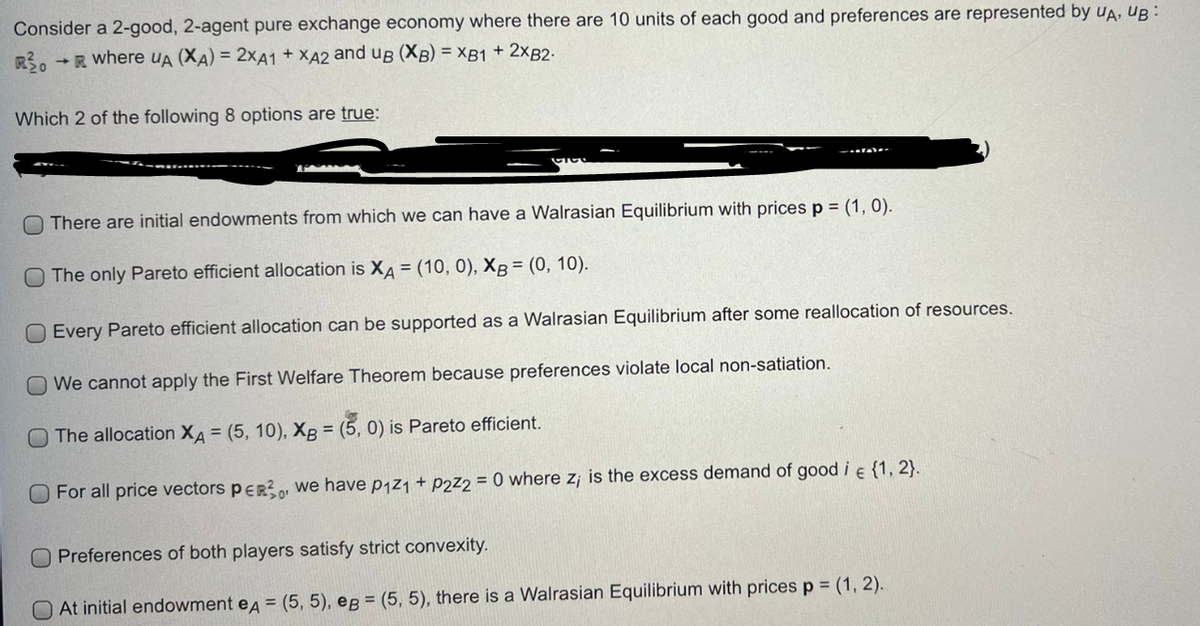Consider a 2-good, 2-agent pure exchange economy where there are 10 units of each good and preferences are represented by DA, UB R30 →R where UA (XA) = 2XA1 + XA2 and uB (XB) = XB1 + 2XB2- Which 2 of the following 8 options are true: There are initial endowments from which we can have a Walrasian Equilibrium with prices p = (1, 0). O The only Pareto efficient allocation is XA = (10, 0), XB = (0, 10). O Every Pareto efficient allocation can be supported as a Walrasian Equilibrium after some reallocation of resources. We cannot apply the First Welfare Theorem because preferences violate local non-satiation. The allocation XA = (5, 10), XB = (5, 0) is Pareto efficient.
Consider a 2-good, 2-agent pure exchange economy where there are 10 units of each good and preferences are represented by DA, UB R30 →R where UA (XA) = 2XA1 + XA2 and uB (XB) = XB1 + 2XB2- Which 2 of the following 8 options are true: There are initial endowments from which we can have a Walrasian Equilibrium with prices p = (1, 0). O The only Pareto efficient allocation is XA = (10, 0), XB = (0, 10). O Every Pareto efficient allocation can be supported as a Walrasian Equilibrium after some reallocation of resources. We cannot apply the First Welfare Theorem because preferences violate local non-satiation. The allocation XA = (5, 10), XB = (5, 0) is Pareto efficient.
Chapter13: General Equilibrium And Welfare
Section: Chapter Questions
Problem 13.5P
Related questions
Question

Transcribed Image Text:Consider a 2-good, 2-agent pure exchange economy where there are 10 units of each good and preferences are represented by UA, UB:
RR where uA (XA) = 2XA1 + XA2 and uB (XB) = XB1 + 2XB2-
Which 2 of the following 8 options are true:
There are initial endowments from which we can have a Walrasian Equilibrium with prices p = (1, 0).
O The only Pareto efficient allocation is XA = (10, 0), XB = (0, 10).
Every Pareto efficient allocation can be supported as a Walrasian Equilibrium after some reallocation of resources.
We cannot apply the First Welfare Theorem because preferences violate local non-satiation.
The allocation XA = (5, 10), XB = (5, 0) is Pareto efficient.
For all price vectors PER3 we have p1z₁ + P2z2 = 0 where z; is the excess demand of good i € {1, 2}.
O Preferences of both players satisfy strict convexity.
At initial endowment eA= (5, 5), eg = (5, 5), there is a Walrasian Equilibrium with prices p = (1, 2).
Expert Solution
This question has been solved!
Explore an expertly crafted, step-by-step solution for a thorough understanding of key concepts.
Step by step
Solved in 2 steps

Knowledge Booster
Learn more about
Need a deep-dive on the concept behind this application? Look no further. Learn more about this topic, economics and related others by exploring similar questions and additional content below.Recommended textbooks for you









Economics (MindTap Course List)
Economics
ISBN:
9781337617383
Author:
Roger A. Arnold
Publisher:
Cengage Learning